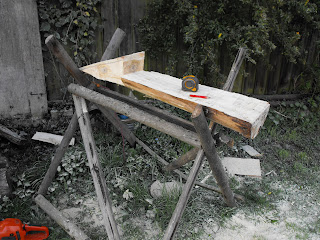West Wood SSSI - site visit wth Natural England
Hey there kids,
I wanted to tell you a little bit about a little trip I went on yesterday with work. As you know, up until this point I have been working with the Harvesting team, dealing with cutting trees down and getting them to roadside so they can be sold. This week, I have been transferred over to the 'Forest Conservancy', who deal with giving people licenses to fell trees (a way of regulating people from cutting down whatever they want) and award grants to people who want to plant or improve upon existing woodland, usually native.
Yesterday, I got invited to attend a meeting between people from Natural England who deal with farmers and trying to look after their land responsibly (Higher Land Stewardship scheme) and representatives from our office at the F.C.
In the morning we had some presentations by various people about what grants were available and who should apply for them, as well as some information about the Woodfuel situation in East Anglia and the Forest Schools initiative. We were in one of these lovely old timber framed buildings, down in Essex:
In the afternoon, we went out to visit a nearby woodland which is being managed by a local Wildlife Trust with funding from the Forestry Commission. We gave them funding to remove a large amount of pendulous sedge (Carex pendula), a very coarse grass which smothers out any natural regeneration of broadleaves and other plants. The wood is protected for its wildflower species, including oxslips (Primula elatior) and several species of orchid. We also gave a grant for them to assess numbers of deer, and subsequent funding for them to pay for stalking which is still ongoing. The deer numbers have been greatly reduced over the years, and now you can really see the benefits in the quality of the understory (lower levels of canopy) and lack of browsing damage.
This guy Michael is the volunteer Warden of West Wood: he co-ordinates and joins in on the work. What a dude.
Here is David Hooten, from the Deer initiative, commenting on an Ash stool which has been browsed by deer. You can see it is small and bushy, like it has been pruned, instead of having lots of long thin leaders:
Here is a section of the coppice which was felled 1 year ago - you can see the re-growth already, helped by the chestnut fencing around the outside and intensive deer management.
And this is what it should like in 10 - 15 years, when it is ready to cut again.

The great advantages of a coppice system, in terms of wildlife benefits, is that you get a huge range of ages and structures across a woodland. This particular wood had 20 coups or cants, one cut each year. This also means you have a steady supply of material for building, firewood or green woodworking. This is how almost all woodland would have been managed in Britain up until the first World War.
Well, there you go. A brief and exciting overview of coppicing. If you have any questions, post them in the comments below. If you want to see more pictures, check my facebook: http://facebook.com/lwhemmings
Now, I'm off to watch England vs. Egypt at the pub!
Much Love, Luke x
Listening to: Ali Farka Touré – Tabara on Spotify





Comments
Post a Comment